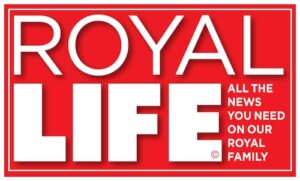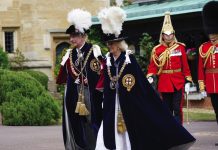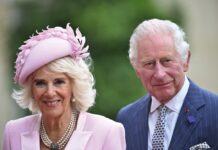
THE KING, COLONEL IN CHIEF, THE HOUSEHOLD DIVISION, WILL PRESENT NEW COLOURS AT WINDSOR CASTLE
Monday 10th June 2024
His Majesty The King, Colonel-in-Chief, The Household Division, will present new colours to No. 9 and No. 12 Company Irish Guards at Windsor Castle, Berkshire.
The new colours will be those trooped in the trooping of the colour at His Majesty’s official birthday parade in London on Saturday 15th June.
The Presentation of New Colours Parade at Windsor Castle will start with the Band of the Irish Guards, led by the Irish Guards’ regimental mascot, an Irish wolfhound named Turlough Mor, marching the Irish Guards into Windsor Castle’s Quadrangle via the George IV Gate.
The old colours will be marched off parade and the new colours will be laid on a drum stack altar.
The King, accompanied by the Irish Guards Regimental Lieutenant Colonel, Major General Sir Christopher Ghika KCVO CBE, will arrive in the Quadrangle from the Sovereign’s Entrance and proceed to a dais facing the parade. To mark His Majesty’s arrival, there will be a royal salute and the national anthem will be played.
His Majesty will then inspect the Guardsmen and Officers on parade before the Chaplain General consecrates the colours with a blessing. His Majesty will present the colours to two junior officers.
His Majesty will then move to the dais where he will address the parade before the parade marches off.
The King is Colonel in Chief of the seven Guards regiments of the Household Division, with the regiments often being seen on ceremonial guard duty at the Royal Palaces.
In March 2023, Her Royal Highness The Princess of Wales took over the role of Colonel of the Irish Guards from the Prince of Wales.
The Irish Guards traditionally comprise troops from the Republic of Ireland, Northern Ireland, Liverpool and Birmingham, as well as Fiji, the Commonwealth and the rest of the UK.
The colours, comprise a regimental colour and the King’s Colour. They are the heart of a regiment, adorned with its emblems and battle honours. They are a part of the Irish Guards’ legacy, representing those that have fought and died for the regiment.
Originally used as rallying points for troops on the battlefield, they are not just regal artworks. To this day they accompany soldiers on operations and, more visibly, on ceremonial duties. Before active duty, colours are consecrated in a ceremony of prayers and blessings, held today for the Irish Guards in the Quadrangle of Windsor Castle.
The King’s Colour is made of silk damask, with gold-thread embroidery and fringe and the star of the most illustrious order of St Patrick at its centre. The regimental colour, used more routinely for duties such as the Changing of the Guard at Buckingham Palace, is embroidered with the number 12, signalling 11 forebear company badges, and a flaming castle. The regiment has been awarded 52 honorary distinctions (commonly known as battle honours), 21 of which appear on the colours.
The Irish Guards are dual-role soldiers who first and foremost deliver excellence as infantrymen, serving in various major conflicts, including both world wars and in Afghanistan since they were raised by Queen Victoria in 1900. In 2024, the Irish Guards have deployed on a range of security force assistance tasks and multinational exercises from the Horn of Africa to the swamps of Louisiana, strengthening capabilities and relationships with allied nations and partner forces.









